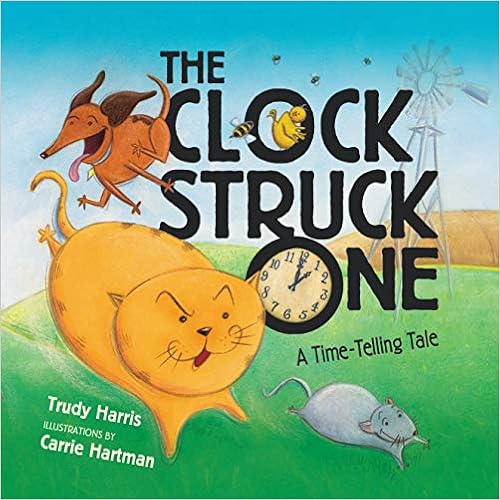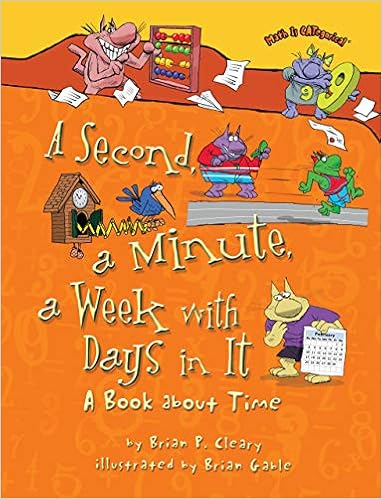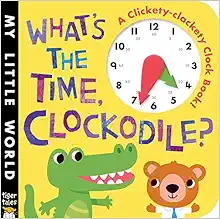20 Best Books for Teaching the Concept of Time to Autistic Children
This resource was created as a supplement for the Language Builder: ARIS® Academic Readiness Intervention System complete early autism curriculum, Lesson #194, Receptive Time - Analog and Lesson #195, Expressive Time - Analog, and Lesson #196, Matching Digital to Analog Time. Download a free copy of lesson 194, lesson 195, and lesson 196 and learn more about ARIS here.
Raising a child to be independent in daily living skills is a shared goal of parents, regardless of their child’s mental, behavioral, or physical diagnosis. Autistic learners may have a higher rate of difficulty in mastering some academic tasks that prelude independence in self-management and daily living skills. With supportive teaching strategies and personalized prompting, learners can be successful at developing and building the necessary strengths to be independent across environments.
Learning to tell time by referencing a clock -- digital or analog -- is a competency that is needed to advance further self-management skills. The ability to read a clock and accurately identify time is a life skill. This is a prerequisite competence for being able to independently follow a schedule, which must be followed across environments such as home, school, and work.
Digital clocks are often easier to teach and learn compared to analog clocks. The student will need to demonstrate the prerequisite skill of tacting (labeling) single and double-digit numbers prior to expressively identifying time on a clock. It is recommended to teach the receptive skill of identifying a clock with a target time (Which one shows 3 o’clock?) in an array of clocks prior to teaching a learner to expressively label the time on a clock. Once they have mastered the skills of receptive and expressive identification of time on a clock, a learner can be taught to match the time on a digital clock to the corresponding time on an analog clock.
Several of the books below include a practice clock for readers to manipulate as they move through the story. This provides a multi-modal sensory approach to learning that improves skill acquisition and retention, compared to learning with only 2-D materials.1
1. The Clock Struck One: A Time-Telling Tale by Trudy Harris
 This story is filled with rhyming and extends upon the familiar “Hickory Dickory Dock” nursery rhyme. The learner will follow the antics of a mouse as it encounters different characters at the strike of each hour. The tired animals fall asleep at midnight. Analog clocks and digital clocks are present throughout the book. The illustrations reflect the color of the sky and activities associated with each hour on the clock, thus connecting the concept of time to the reader’s perspective.
This story is filled with rhyming and extends upon the familiar “Hickory Dickory Dock” nursery rhyme. The learner will follow the antics of a mouse as it encounters different characters at the strike of each hour. The tired animals fall asleep at midnight. Analog clocks and digital clocks are present throughout the book. The illustrations reflect the color of the sky and activities associated with each hour on the clock, thus connecting the concept of time to the reader’s perspective.
2. Bats Around the Clock by Kathi Appelt
 Learners have the opportunity to follow along and imitate the dance moves of the bats in the bat jamboree as they learn to tell time. An analog clock representing the time on the hour is shown on each page for learners to practice recognizing the numbers and hands on a clock. This book is a great supplement to a nocturnal animal or Halloween theme!
Learners have the opportunity to follow along and imitate the dance moves of the bats in the bat jamboree as they learn to tell time. An analog clock representing the time on the hour is shown on each page for learners to practice recognizing the numbers and hands on a clock. This book is a great supplement to a nocturnal animal or Halloween theme!
3. A Second, a Minute, a Week with Days in It: A Book about Time by Brian P Cleary
 Readers learn about measurements of time starting with seconds all the way through decades! This book is most appropriate for advanced learners who have begun to understand the ideas of time. Analog clocks are shown throughout the book, as are other items that measure time such as a stopwatch. This book is recommended for helping children understand the broad concept of time and generalize their skills related to time recognition.
Readers learn about measurements of time starting with seconds all the way through decades! This book is most appropriate for advanced learners who have begun to understand the ideas of time. Analog clocks are shown throughout the book, as are other items that measure time such as a stopwatch. This book is recommended for helping children understand the broad concept of time and generalize their skills related to time recognition.
4. Telling Time: How to Tell Time on Digital and Analog Clocks
 Moving beyond simply labeling time on a clock, this book helps learners further their understanding of the concept of time. This text discusses days of the week and common daily activities that occur at specific times. Digital and analog clocks are included in the illustrations, as well as calendars and watches. This book is helpful in teaching learners to generalize their skills.
Moving beyond simply labeling time on a clock, this book helps learners further their understanding of the concept of time. This text discusses days of the week and common daily activities that occur at specific times. Digital and analog clocks are included in the illustrations, as well as calendars and watches. This book is helpful in teaching learners to generalize their skills.
5. How to Tell Time, Fun Activity Book to Teach Kids Time! by Angel Duran
 The simple illustrations within this activity book are supportive of learners who are being introduced to the concept of referencing time with a clock. Analog and digital clocks are clearly shown with added text to explain the key points of how to visually reference a clock. There are additional pages in the book that provide the opportunity for students to practice expressively writing the time on a clock.
The simple illustrations within this activity book are supportive of learners who are being introduced to the concept of referencing time with a clock. Analog and digital clocks are clearly shown with added text to explain the key points of how to visually reference a clock. There are additional pages in the book that provide the opportunity for students to practice expressively writing the time on a clock.
6. When the Clock Strikes on Christmas Eve by Lisa Ferland
 This sweet story is a perfect complement to the winter holidays, as the reader will journey through each hour of the day as Christmas day approaches. Visual perceptual skills are strengthened as the learner searches for a candy cane on every page. An analog clock is presented on each page as a way to reinforce the concept of telling time.
This sweet story is a perfect complement to the winter holidays, as the reader will journey through each hour of the day as Christmas day approaches. Visual perceptual skills are strengthened as the learner searches for a candy cane on every page. An analog clock is presented on each page as a way to reinforce the concept of telling time.
7. Disney Mickey Mouse Clubhouse Time to Play! Learn to Tell Time Sound Book with Toy Clock
 Follow along with the beloved character of Mickey Mouse as you and your young reader learn to tell time! Learners will find joy in interacting with the rotating clock and story sound buttons within this book. The reader will engage in critical thinking and strengthen their receptive and expressive language skills as they respond to questions such as “What time do you go to bed?” or “What time do you eat lunch?”
Follow along with the beloved character of Mickey Mouse as you and your young reader learn to tell time! Learners will find joy in interacting with the rotating clock and story sound buttons within this book. The reader will engage in critical thinking and strengthen their receptive and expressive language skills as they respond to questions such as “What time do you go to bed?” or “What time do you eat lunch?”
8. How to Tell Time: A Lift-the-Flap Guide to Telling Time
 The interactive flaps within the book are sure to be a hit with hands-on learners. This book highlights the different intervals of time such as a minute, a quarter of an hour, and a half of an hour. Days of the week, months of the year, and the variety of seasons are detailed as ways of measuring extended units of time. Illustrations are colorful, simple, and relevant to items that learners see frequently in their home and/or school environment.
The interactive flaps within the book are sure to be a hit with hands-on learners. This book highlights the different intervals of time such as a minute, a quarter of an hour, and a half of an hour. Days of the week, months of the year, and the variety of seasons are detailed as ways of measuring extended units of time. Illustrations are colorful, simple, and relevant to items that learners see frequently in their home and/or school environment.
9. My First Clock Book (Priddy Learning)
 The story is told throughout a typical school day. Learners have the opportunity to move the hour and minute hand on the cutout clock that is attached to the book. This allows the reader to practice matching the time on the interactive clock to the printed clock on each page. This is an excellent first introductory book for young learners who are being introduced to the concept of telling time using a clock.
The story is told throughout a typical school day. Learners have the opportunity to move the hour and minute hand on the cutout clock that is attached to the book. This allows the reader to practice matching the time on the interactive clock to the printed clock on each page. This is an excellent first introductory book for young learners who are being introduced to the concept of telling time using a clock.
10. Tell the Time: with Interactive Clock Hands to Turn by Igloo Books
 The board book format of this story is sturdy enough to allow the learner to actively engage with the moveable clock within the book. The text gives explicit instructions for young learners to follow as a way of learning to demonstrate specific times on a clock. Digital and analog clocks are represented throughout this story, thus teaching matching as well as expressive and receptive identification of time.
The board book format of this story is sturdy enough to allow the learner to actively engage with the moveable clock within the book. The text gives explicit instructions for young learners to follow as a way of learning to demonstrate specific times on a clock. Digital and analog clocks are represented throughout this story, thus teaching matching as well as expressive and receptive identification of time.
11. How to Tell Time by Cottage Door Press
 This well-written text comes with a bonus feature -- a make-it-yourself model clock! Readers will learn about how to tell time to the nearest hour. They can use their own analog clock to model and match the time to the clock on the page. Learners will follow along with the daily tasks of the characters and practice receptive and expressive labeling of different analog clocks.
This well-written text comes with a bonus feature -- a make-it-yourself model clock! Readers will learn about how to tell time to the nearest hour. They can use their own analog clock to model and match the time to the clock on the page. Learners will follow along with the daily tasks of the characters and practice receptive and expressive labeling of different analog clocks.
12. Maisy’s First Clock by Lucy Cousins
 Learners travel through a typical day with Maisy. Readers have a myriad of opportunities to engage with this text as they answer questions related to daily tasks and practice demonstrating time by turning the hands on their own analog clock. As each hour passes, new adventures await!
Learners travel through a typical day with Maisy. Readers have a myriad of opportunities to engage with this text as they answer questions related to daily tasks and practice demonstrating time by turning the hands on their own analog clock. As each hour passes, new adventures await!
13. What’s the Time, Clockodile? by Jonathan Litton
 Digital and analog clocks are presented on each page of the book. The variety in visual representation of clocks is beneficial for young learners to generalize their understanding of using clocks to measure and label time. The illustrations are bright and simple and complement the storyline of demonstrating how time progresses throughout each day.
Digital and analog clocks are presented on each page of the book. The variety in visual representation of clocks is beneficial for young learners to generalize their understanding of using clocks to measure and label time. The illustrations are bright and simple and complement the storyline of demonstrating how time progresses throughout each day.
14. What Time Is It, Daniel Tiger? by Maggie Testa
 This delightful story is perfect for young learners who are beginning to understand their routine and the concept of time. The reader travels along with Daniel throughout his day and is invited to move the hands of the clock along with each step of his routine, such as lunchtime, bath time, and bedtime. The clock makes a ticking sound similar to a real clock!
This delightful story is perfect for young learners who are beginning to understand their routine and the concept of time. The reader travels along with Daniel throughout his day and is invited to move the hands of the clock along with each step of his routine, such as lunchtime, bath time, and bedtime. The clock makes a ticking sound similar to a real clock!
15. Poppy and Sam’s Telling the Time Book by Heather Amery
 The characters of this book, Poppy and Sam, live on an apple farm and they are learning to tell time too! The reader will accompany Poppy and Sam on their daily scheduled adventures around the farm. Learners can begin to manipulate the hands on the clock to demonstrate the correct time. This interactive book is great for children of all ages, as caregivers can provide additional prompting to help their child label numbers and reference time.
The characters of this book, Poppy and Sam, live on an apple farm and they are learning to tell time too! The reader will accompany Poppy and Sam on their daily scheduled adventures around the farm. Learners can begin to manipulate the hands on the clock to demonstrate the correct time. This interactive book is great for children of all ages, as caregivers can provide additional prompting to help their child label numbers and reference time.
16. Back to the Future: Telling Time with Mary McFly
 Marty McFly and Doc Brown take young readers on an adventure through time. Learners will have the opportunity to match digital clocks to corresponding analog clocks throughout the book. The text details the function of each hand on the clock. This developmental board book includes flaps to lift and dials to turn on the interactive clock.
Marty McFly and Doc Brown take young readers on an adventure through time. Learners will have the opportunity to match digital clocks to corresponding analog clocks throughout the book. The text details the function of each hand on the clock. This developmental board book includes flaps to lift and dials to turn on the interactive clock.
17. Is It Lunch Time? Is It Dinner Time? Hands on the Clock
 A child learns best when they can relate a concept to their own life. This book builds upon this natural development by teaching the reader to understand time and how it is associated with specific routines throughout the day. This book is perfect for learners who are beginning to learn about the concept of time.
A child learns best when they can relate a concept to their own life. This book builds upon this natural development by teaching the reader to understand time and how it is associated with specific routines throughout the day. This book is perfect for learners who are beginning to learn about the concept of time.
18. Lift the Flap Telling Time
 This book is great for learners who prefer a hands-on learning style. Throughout the text, readers can lift up flaps to reveal different digital and analog clocks, a.m. versus p.m., and the use of 24-hour time systems. Young learners will actively learn about common time intervals such as quarter to, half past, and more!
This book is great for learners who prefer a hands-on learning style. Throughout the text, readers can lift up flaps to reveal different digital and analog clocks, a.m. versus p.m., and the use of 24-hour time systems. Young learners will actively learn about common time intervals such as quarter to, half past, and more!
19. Me Counting Time by Joan Sweeney
 This text focuses on the many ways to measure time. Readers will learn along with the main character as they discover how to measure their age in years and count the minutes that it takes to bake a birthday cake! This book is best suited for more advanced learners who are aware of the concepts of seconds, minutes, hours, days, months, and years.
This text focuses on the many ways to measure time. Readers will learn along with the main character as they discover how to measure their age in years and count the minutes that it takes to bake a birthday cake! This book is best suited for more advanced learners who are aware of the concepts of seconds, minutes, hours, days, months, and years.
20. Telling Time by David A. Adler
 This space-themed book is a wonderful supplement to teaching young learners to expressively and receptively identify the time on a clock. Readers will travel with a group of astronauts and Martian friends to discover the many ways that time can be measured. This book is a delightful introduction to a variety of STEM time-based concepts.
This space-themed book is a wonderful supplement to teaching young learners to expressively and receptively identify the time on a clock. Readers will travel with a group of astronauts and Martian friends to discover the many ways that time can be measured. This book is a delightful introduction to a variety of STEM time-based concepts.
Wang, F., Gao, C., Kaufman, J., Tong, Y., & Chen, J. (2021). Watching versus touching: The effectiveness of a touchscreen app to teach children to tell time. Computers & Education, 160, Article 104021.
This resource was created as a supplement for the Language Builder: ARIS complete early autism curriculum, Lesson #194, Receptive Time - Analog and Lesson #195, Expressive Time - Analog, and Lesson #196, Matching Digital to Analog Time. Download a free copy of lesson 194, lesson 195, and lesson 196 and learn more about ARIS here.

Sheila Hartley, MS, BCBA, LBA
Sheila is an Early Childhood Education Consultant, BCBA, and the owner of SenseSational Learning Group LLC. She specializes in Naturalistic Developmental Behavioral Interventions. Play based learning is her passion and she gathers inspiration from the Reggio Emilia and Montessori approaches to early childhood education. She will graduate in 2023 with a Doctorate of Education in Early Childhood Education.



